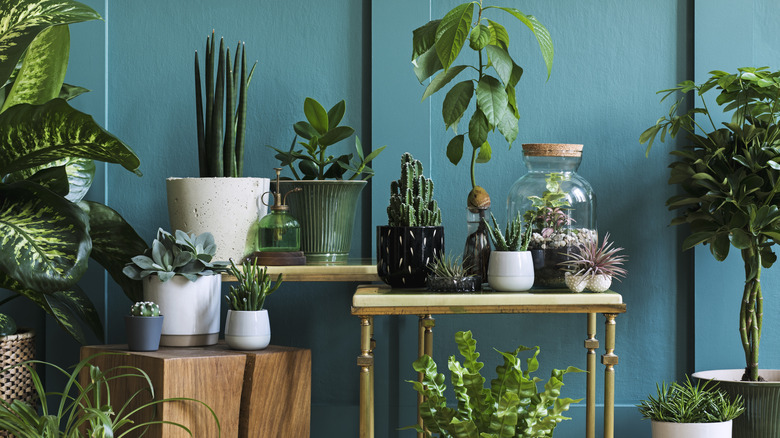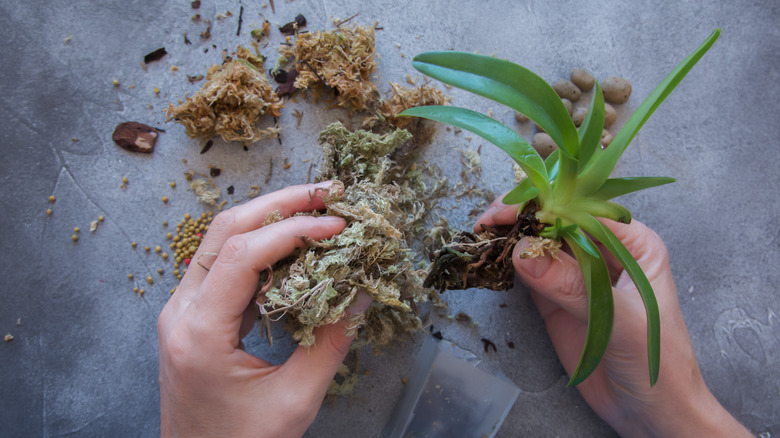How To Grow A Mini Rainforest On A Ceramic Vase & How To Keep It Healthy
We may receive a commission on purchases made from links.
Sometimes it's challenging to adhere to the adage, "Take only photos; leave only footprints," like when you desperately want to pocket all the amazing plants you saw on that once-in-a-lifetime Amazon safari, which you obviously can't do. Luckily, it's actually pretty easy to recreate a rainforest, even in your cold northern home. Attach the right kind of plants — mosses, orchids, and ferns — to a damp ceramic vase with twine, and voila! You have a mini rainforest for any low-light spot in your home. (Hint: now is the right time to learn about epiphytes and how to care for them.)
The concept for this project is inspired by an ancient South American tradition called pau de barro or "clay stick." People attached mosses and other epiphytes — plants that perch in a forking branch or rock crevice, taking their nutrients from the air or rainwater — to a hollow clay cylinder and regularly filled it with water. In this modern houseplant DIY, the plants hug a porous terracotta vase instead of clinging to tree bark like they do in the wild. This might be one of the fun ways to repurpose vases around the house, but is ceramic safe for plants? Clay pots are among the two planter materials (alongside plastic) recommended by the American Orchid Society, especially for humid environments. Just keep in mind that the pH level of clay might be too high for some epiphytic species, and porous ceramic may dry out quickly in warm weather.
Choose a ceramic vase and your preferred rainforest plants
If you're on a budget, use a simple terracotta flower pot without a drainage hole. A porous ceramic vase could easily be among your most valuable items to seek out at a thrift store in this case! Alternatively, invest in one of the purpose-made rainforest garden clay cylinders. Vertplanter's Classic model will set you back $39.99 and has a unique textured tube. An American company, Kool Logs, makes and sells ceramic cylinders that are cast from real trees priced between $8 for one and $40 for multi packs, while Red Leaf Aquascaping offers a small Japanese-made Dooa Terra Base for a little over $30.
Now for the fun part: choosing your plants! Living moss, like Christmas moss, sphagnum moss, or club moss, is a necessary addition to your mini rainforest, as are ferns. Aquarium Plants Factory sells bare root African water ferns (Bolbitis difformis) for about $9 each. Beginner-friendly moth orchids — like Phalaenopsis 'Mini Mark,' $46 at Emerald City Orchids — cling nicely to a ceramic cylinder. Phalaenopsis orchids are good for beginner growers, since as far back as the 1950s. The 'Mini Mark' cultivar, in particular, is a good choice for this project due to its small- to medium-sized blooms. Bromeliads are another colorful, easy-care option. Ambitious? Consider purchasing Utricularia longifolia or long-leaved bladderwort starter plants. Reduce your risk of failure by researching which plants thrive in similar moisture and climatic conditions before you buy.
How to assemble your mini rainforest garden
Fine cotton thread in an organic hue — say, green or brown — is an almost invisible way to tie plants to your vase. Sturdier mounting materials include nylon fishing line, fine PVC-covered wire, old stockings cut into thin strips, bonsai wire, jute twine, teeny pieces of driftwood, or aquatic glue. Grab some scissors to cut the twine. You'll also need something waterproof to sit your vase on and a transparent glass or plastic case or cloche to encase your garden and encourage humidity. You'll also need a long-neck watering can — Amazon sells one by Soiwapot for under $10 — and some distilled water or rainwater.
It's a good idea to sterilize the vase by pouring boiling water over it, but watch for cracking. Optionally, smear the vase exterior with a thin layer of mud to provide your plants with more nutrients. Roll and tie or glue on the living moss layer first, or press it into the damp mud. Not a moss fan? Wrap the vase in a plant growth cloth before attaching your epiphytes. Attach your larger orchids, bromeliads, or other rainforest epiphytes to the vase using your method of choice. Make sure the binding is tight since you don't want it sagging when wet. Fill the clay tube to the brim with water and use an upturned terracotta planter saucer as a lid. Place the garden in its transparent case.

